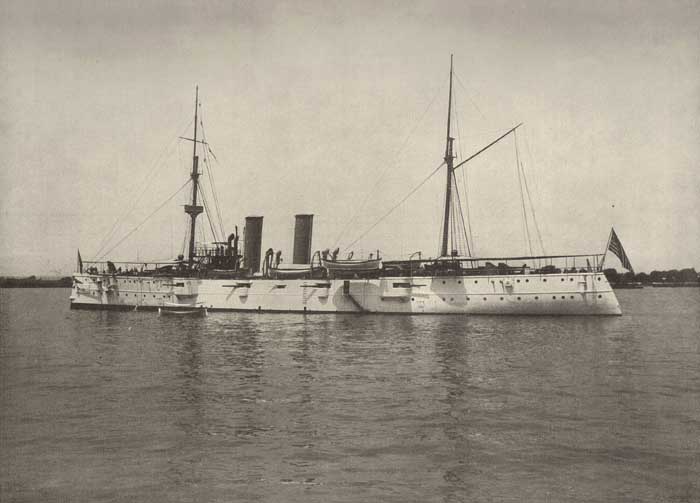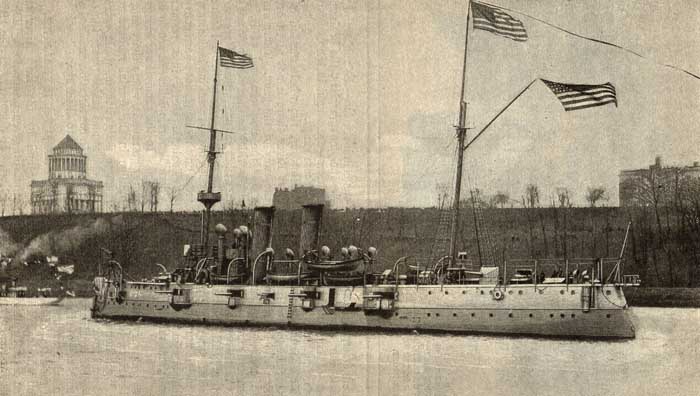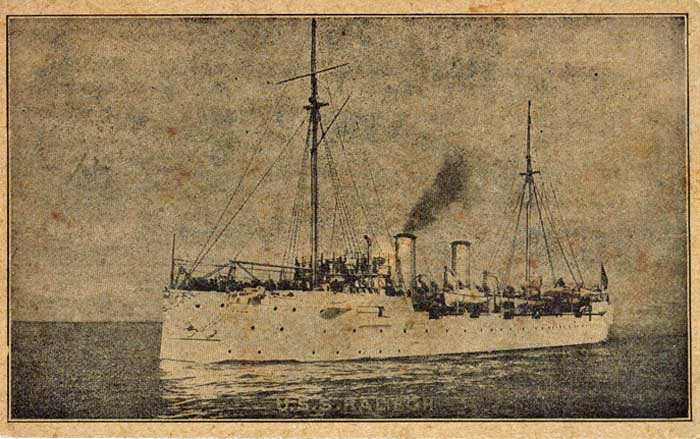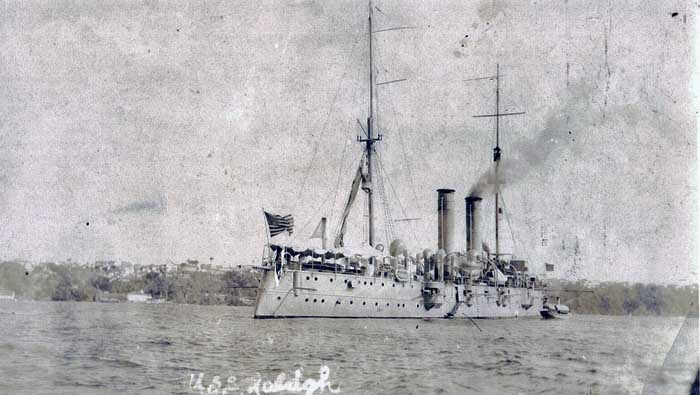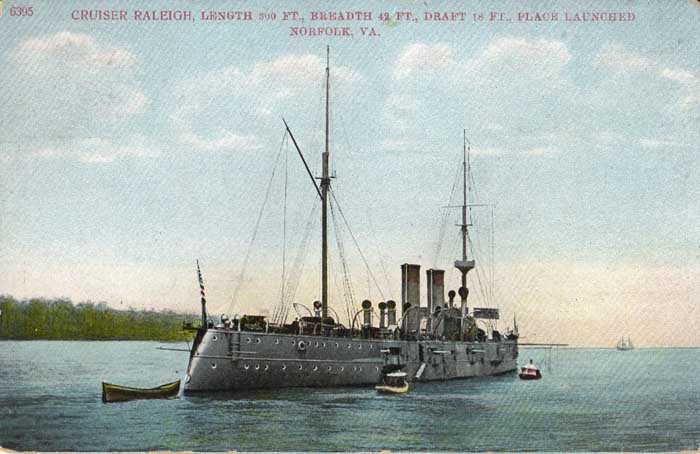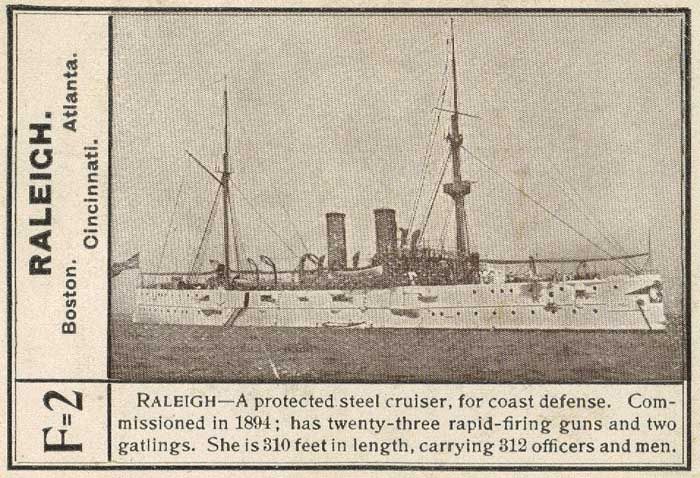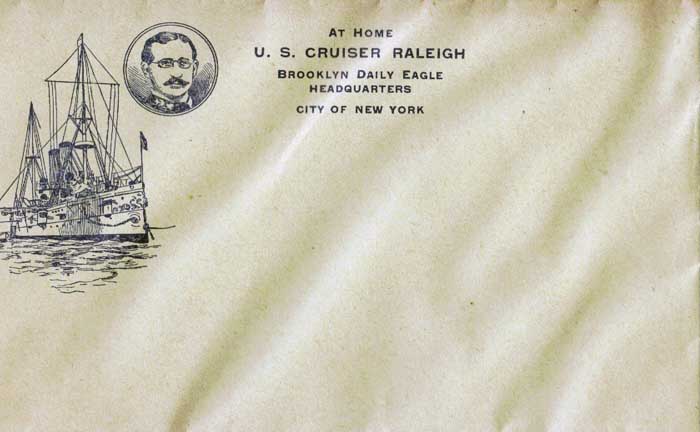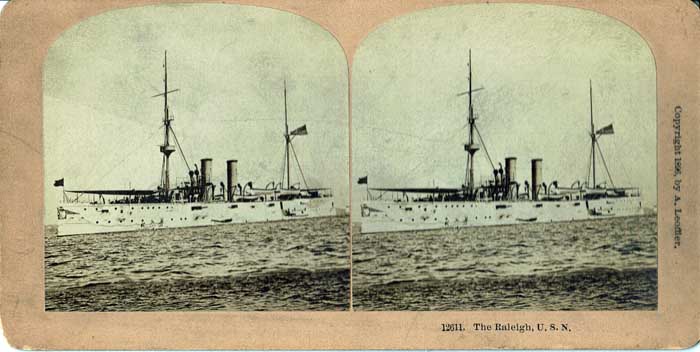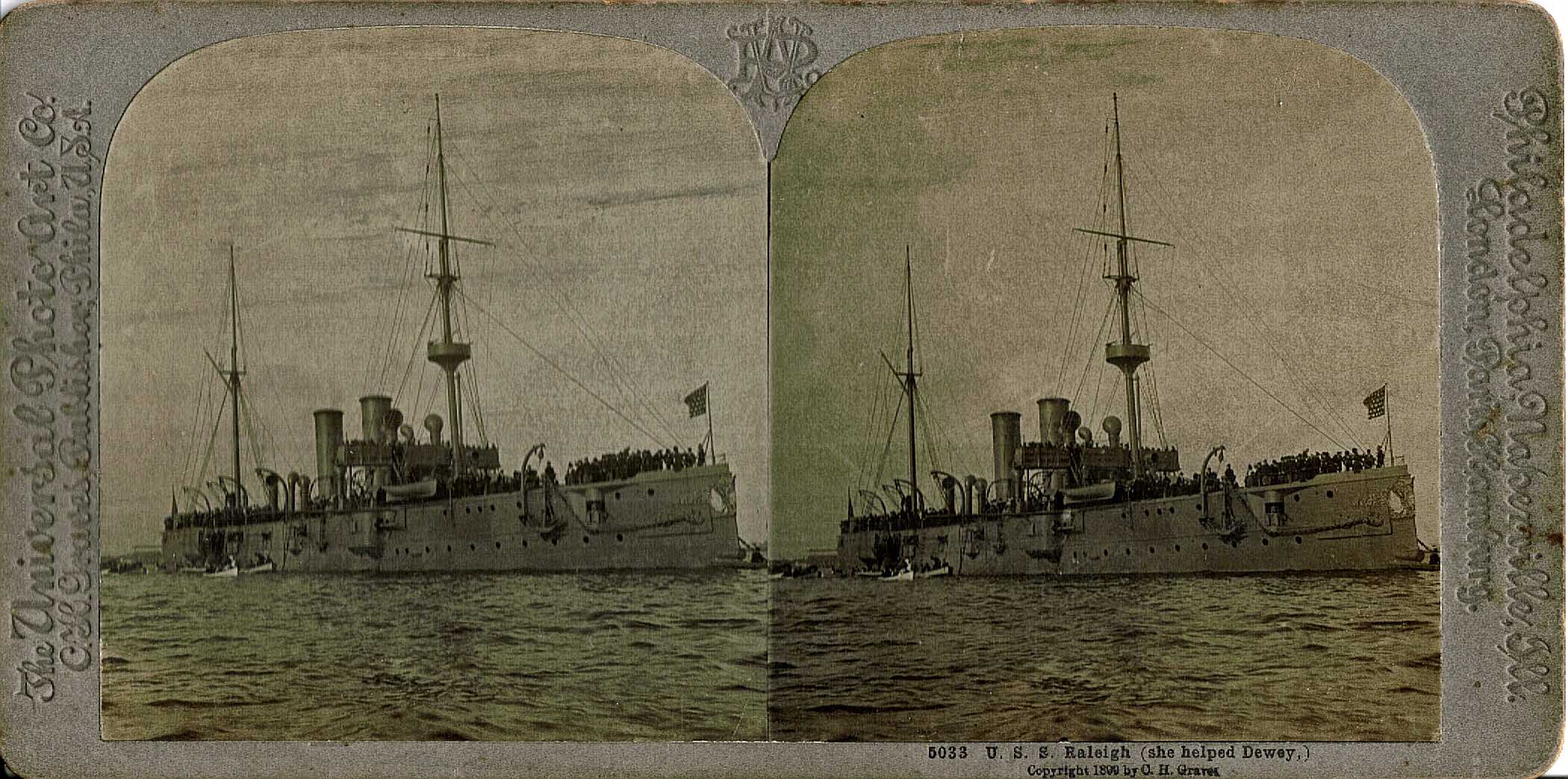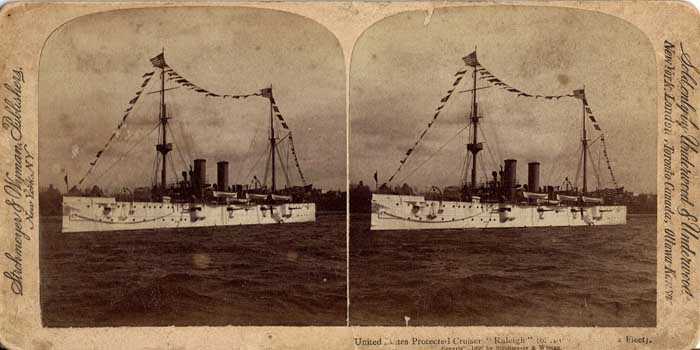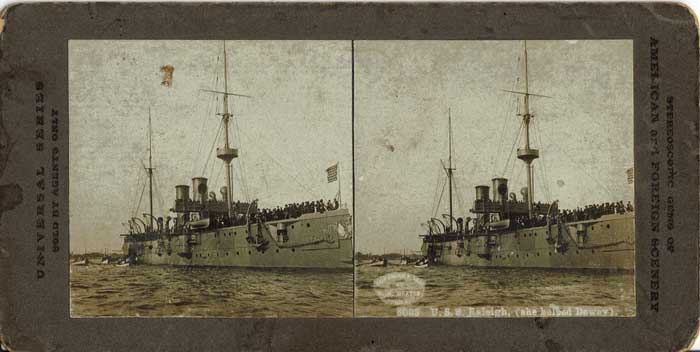The capital of
North Carolina which honors the English explorer Sir Walter Raleigh, the
first to attempt the establishment of an English settlement in North America.
(C - 8: displacement 3,183 (normal); length 305'10"; beam
42'; draft 18' (mean); speed 19 knots; complement 312; armament 1 6",
10 5", 8 6-pounders, 4 1-pounders, 4 18" torpedo tubes; class Cincinnati)
The second Raleigh (C-8) was laid down on 19 December
1889 at the Norfolk Navy Yard, Portsmouth, Va.; launched 31 March 1892;
sponsored by Mrs. Alfred W. Haywood; and commissioned on 17 April 1894,
Capt. Merrill Miller in command.
Remaining in the yard for another 5 months, Raleigh shifted
to Hampton Roads in early September, then conducted shakedown in Chesapeake
Bay. In January 1895, she completed fitting out at the torpedo station
at Newport, R.I., and on the 25th, put to sea to join the North Atlantic
Squadron for battle practice in the Caribbean. In June, she put into New
York, whence she moved south again for a cruise around the Florida peninsula;
and in August, she returned to New York for voyage repairs before resuming
operations with her squadron. For the next 10 months, she continued operations
in the western Atlantic, ranging from New England to the Straits of Florida.
During the summer of 1896, she trained Naval Militiamen
from South Carolina and Louisiana, then returned to the east coast and
North Atlantic Squadron exercises. From late October to early February
1897, she joined in a neutrality patrol off Florida, and in April, after
the completion of an overhaul at Norfolk, participated in ceremonies marking
the dedication of Grant's Tomb.
On 6 May, Raleigh steamed east and, on 11 June, reported
for duty on the European Station at Smyrna (now Izmir) on the Aegean Sea.
In July, she participated in a good-will tour of Moroccan ports. In August,
she cruised off Italy, then returned to the western Mediterranean. Into
December, she operated off the Levant and, toward the end of the month
transited the Suez Canal en route to the Asiatic Station. On 18 February
1898, she reached Hong Kong where she joined Dewey's squadron.
On 26 April, the U.S. Congress declared war against Spain.
On the 27th the squadron got underway for Manila.
At the end of the month, Raleigh passed El Fraile Island
and was fired on by an enemy battery. With Concord (PG-3) and Boston,
she returned the fire, then moved toward Cavite to engage the Spanish
fleet.
Steaming in column, the American squadron ran by the Spanish,
firing at close range. Two hours later, five cross runs had been completed,
and the Spanish fleet had been destroyed. Shore batteries became the targets.
Just before noon on 1 May, Raleigh joined Olympia (C-6), Boston, and Petrel
(PG-2) in silencing the navy yard and arsenal batteries. On 2 May, she
sent officers ashore to demand the surrender of Corregidor and, on the
3d, sent men to disable the batteries there and destroy the munitions.
In the late afternoon, shore parties were sent to Palo Caballo for the
same purpose. Raleigh then took up picket and patrol duties, capturing
the gunboat Callao on the 9th.
In July, Raleigh shifted from Manila Bay to Subic Bay.
On the 7th, she shelled Spanish positions on Grande Island until they
were surrendered; she then sent garrison troops ashore. On the 10th, she
returned to Manila, where she remained until after the Spanish surrendered
the city in mid-August.
On the 25th, Raleigh put to sea, bound for Hong Kong with
mail. In early September, she returned to the Philippines where she operated
until sailing for Suez, Gibraltar, and the United States on 15 December.
On 15 April 1899, she arrived at New York and the next day received honors
from other ships and from officials of the city.
Ten days after her arrival, Raleigh cleared New York Harbor
and turned south. On the 26th, she entered the Delaware River and moved
up to Philadelphia, where on the 28th, President McKinley and Secretary
of the Navy Long came on board to honor the ship and crew for a job well
done.
On 2 May, Raleigh got underway again, and, after visiting
ports in the Carolinas, put into Portsmouth, N.H., where she was decommissioned
on 10 June.
Recommissioned on 5 January 1903, Raleigh was fitted out
at New York and in mid-March sailed for Honduras. There, she delivered
stores to ships cruising off that coast, then headed east. Steaming via
Gibraltar and Suez, she rejoined the Asiatic Fleet at Chefoo, China, on
26 August.
For the next 4 years she cruised in Korean, Chinese, Japanese,
and Philippine waters in support of diplomatic missions as well as showing
the flag and conducting good-will tours. On 12 August 1907, she departed
Yokosuka for San Francisco. Arriving on 6 September, she proceeded to
Mare Island to begin inactivation.
Decommissioned on 12 October 1907, Raleigh was recommissioned
on 21 February 1911. Initially assigned to the Pacific Reserve Squadron,
she remained in San Francisco until December. She then moved north to
Bremerton, Wash., and 2 more years of little activity.
On 6 December 1913, she departed Puget Sound. Steaming
south, she joined the active fleet and served as a station ship in Mexican
ports, primarily Manzanillo, Mazatlan, La Paz, and Guaymas, for the next
4 years. During the time she interrupted her Mexican assignments twice:
for duty at Ocos, Guatemala, from 6 to 25 October 1915; and at Corinto,
Nicaragua, from 1 April to 26 July 1916.
Undergoing repairs at Mare Island when the United States
entered World War I, Raleigh departed San Francisco in early May 1917
and on 5 June joined the Patrol Force, U.S. Atlantic Fleet, at Newport,
R.I. Assigned to Cruiser Force, 2d Squadron, she patrolled from Boston
to Norfolk until November when she was detached for duty in Brazilian
waters.
On 12 December, Raleigh arrived at Rio de Janeiro and
until 27 April 1918, she patrolled between there and Bahia (Salvador).
In May, she arrived off West Africa; delivered munitions to the Liberian
Government; continued on to Dakar, French West Africa, then, on 18 May,
headed west. At the end of the month, she resumed Bahia-Rio patrols.
At the same time, however, German U-boats appeared off
the east coast of the United States. Raleigh was ordered home.
Clearing Bahia on 26 June, she joined the American Patrol
Detachment at Key West, Fla., on 21 July and began guarding convoys in
the Gulf of Mexico, in the Caribbean, and off the east coast of the Carolinas.
She remained on that duty until after the end of the war and, into 1919,
continued operations out of Key West. On 6 April she entered the Charleston
Navy Yard and prepared for inactivation. On 21 April 1919 she was decommissioned
for the last time and on 5 August 1921, she was sold for scrapping to
Henry A. Hitner's Sons Co., Philadelphia Pa.
From the collection of Marcus W. Robbins
Birth
of the Gosport Yard & into the 19th Century
Battle
of the Hampton Roads Ironclads
The Norfolk Navy Yard into the 20th Century
Image
Index
